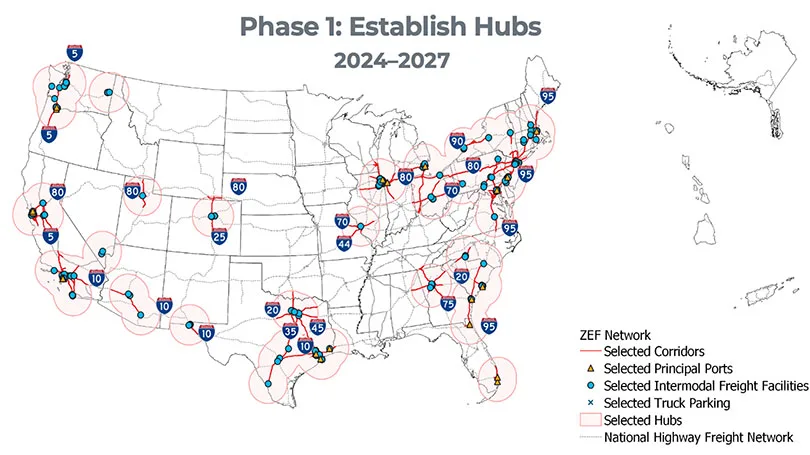One of the longest-lead time items necessary for charging electric trucks and buses is obtaining sufficient electrical power. The process unveiled today by federal officials offers a roadmap and forum for a wide group of stakeholders to prepare for medium and heavy-duty electric vehicles at key locations by highlighting to utilities and their regulators (who must approve all infrastructure investments) hotspots where such power will be required.
This effort may lead to proactive efforts such as building backbone infrastructure before customers place orders with their utility for many megawatts of power. Such advance planning can mitigate the risk that a lack of electrical capacity will stand in the way when a fleet owner wants to deploy trucks or buses on relatively short notice.
The new National Zero-Emission Freight Corridor Strategy establishes a framework for deploying charging infrastructure along freight corridors, at intermodal freight facilities, and high-usage ports. Developed by the Joint Office of Energy and Transportation, in collaboration with the U.S. Department of Energy (DOE), U.S. Department of Transportation (DOT), and the Environmental Protection Agency (EPA), the strategy calls for public investment to amplify private sector momentum, focus utility and regulatory energy planning, align industry activity, and mobilize communities for clean transportation in four phases:
- 2024 to 2027: Establish Hubs
- 2027 to 2030: Connect Corridors
- 2030 to 2035: Expand Network
- 2035 to 2040: Complete Network
The goal is to help stakeholders, including commercial truck fleets, landowners, developers, electric utilities, zoning and other local officials, energy and environmental regulators, and communities, evaluate where new electrical infrastructure is likely to be needed. This process is already being manifested in certain locations such as New York, where the Public Service Commission established a proceeding to address barriers to medium and heavy-duty EV charging infrastructure.
Factors which determine priority areas for electrifying medium and heavy-duty trucks include:
- The most heavily used freight corridor segments by freight volume on the National Highway Freight Network (which consists of approximately 60,000 miles of roadway across the country);
- The most heavily used ports by annual freight tonnage, intermodal freight facilities, and key truck
service facility locations; - Projected zero-emission medium and heavy duty EV volumes that demonstrate optimal total cost of ownership compared to internal combustion engine trucks (expected to begin with first- to last-mile delivery, local and regional haul, and moving toward long-haul transportation);
- Locations that bear disproportionate environmental and air quality burden from medium and heavy-duty vehicles and are in nonattainment for criteria air pollutants;
- States with policies that enable ZEV deployment; and
- “On-the-ground” planning for ZE-MHDVs through DOE’s commercial ZEV corridor
planning grants.
The first phase of the federal effort includes defining high-volume freight zones such as ports, intermodal facilities, and truck parking; these zones are shown on the map above.
If you are at a utility, fleet operator, or agency that is, or is expecting to be, involved in electrifying for medium and heavy duty vehicles or providing energy or infrastructure for these applications, I invite you to contact EV Advisors.

